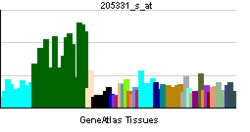REEP2
| REEP2 | ||||||
|---|---|---|---|---|---|---|
| Identifiers | ||||||
| Aliases | REEP2, C5orf19, SGC32445, SPG72, Yip2d, receptor accessory protein 2 | |||||
| External IDs | MGI: 2385070 HomoloGene: 41146 GeneCards: REEP2 | |||||
| RNA expression pattern | ||||||
 | ||||||
| More reference expression data | ||||||
| Orthologs | ||||||
| Species | Human | Mouse | ||||
| Entrez | ||||||
| Ensembl | ||||||
| UniProt | ||||||
| RefSeq (mRNA) | ||||||
| RefSeq (protein) | ||||||
| Location (UCSC) | Chr 5: 138.44 – 138.45 Mb | Chr 18: 34.84 – 34.85 Mb | ||||
| PubMed search | [1] | [2] | ||||
| Wikidata | ||||||
| View/Edit Human | View/Edit Mouse |
Receptor expression-enhancing protein 2 is a protein that in humans is encoded by the REEP2 gene.[3][4][5]
References
- ↑ "Human PubMed Reference:".
- ↑ "Mouse PubMed Reference:".
- ↑ Clark AJ, Metherell LA, Cheetham ME, Huebner A (Nov 2005). "Inherited ACTH insensitivity illuminates the mechanisms of ACTH action". Trends Endocrinol Metab. 16 (10): 451–7. doi:10.1016/j.tem.2005.10.006. PMID 16271481.
- ↑ Saito H, Kubota M, Roberts RW, Chi Q, Matsunami H (Nov 2004). "RTP family members induce functional expression of mammalian odorant receptors". Cell. 119 (5): 679–91. doi:10.1016/j.cell.2004.11.021. PMID 15550249.
- ↑ "Entrez Gene: REEP2 receptor accessory protein 2".
Further reading
- Maruyama K, Sugano S (1994). "Oligo-capping: a simple method to replace the cap structure of eukaryotic mRNAs with oligoribonucleotides.". Gene. 138 (1–2): 171–4. doi:10.1016/0378-1119(94)90802-8. PMID 8125298.
- Andersson B, Wentland MA, Ricafrente JY, et al. (1996). "A "double adaptor" method for improved shotgun library construction". Anal. Biochem. 236 (1): 107–13. doi:10.1006/abio.1996.0138. PMID 8619474.
- Yu W, Andersson B, Worley KC, et al. (1997). "Large-Scale Concatenation cDNA Sequencing". Genome Res. 7 (4): 353–8. doi:10.1101/gr.7.4.353. PMC 139146
 . PMID 9110174.
. PMID 9110174. - Suzuki Y, Yoshitomo-Nakagawa K, Maruyama K, et al. (1997). "Construction and characterization of a full length-enriched and a 5'-end-enriched cDNA library". Gene. 200 (1–2): 149–56. doi:10.1016/S0378-1119(97)00411-3. PMID 9373149.
- Lai F, Godley LA, Joslin J, et al. (2001). "Transcript map and comparative analysis of the 1.5-Mb commonly deleted segment of human 5q31 in malignant myeloid diseases with a del(5q)". Genomics. 71 (2): 235–45. doi:10.1006/geno.2000.6414. PMID 11161817.
- Strausberg RL, Feingold EA, Grouse LH, et al. (2003). "Generation and initial analysis of more than 15,000 full-length human and mouse cDNA sequences". Proc. Natl. Acad. Sci. U.S.A. 99 (26): 16899–903. doi:10.1073/pnas.242603899. PMC 139241
 . PMID 12477932.
. PMID 12477932. - Ota T, Suzuki Y, Nishikawa T, et al. (2004). "Complete sequencing and characterization of 21,243 full-length human cDNAs". Nat. Genet. 36 (1): 40–5. doi:10.1038/ng1285. PMID 14702039.
- Gerhard DS, Wagner L, Feingold EA, et al. (2004). "The Status, Quality, and Expansion of the NIH Full-Length cDNA Project: The Mammalian Gene Collection (MGC)". Genome Res. 14 (10B): 2121–7. doi:10.1101/gr.2596504. PMC 528928
 . PMID 15489334.
. PMID 15489334.
This article is issued from Wikipedia - version of the 6/3/2016. The text is available under the Creative Commons Attribution/Share Alike but additional terms may apply for the media files.